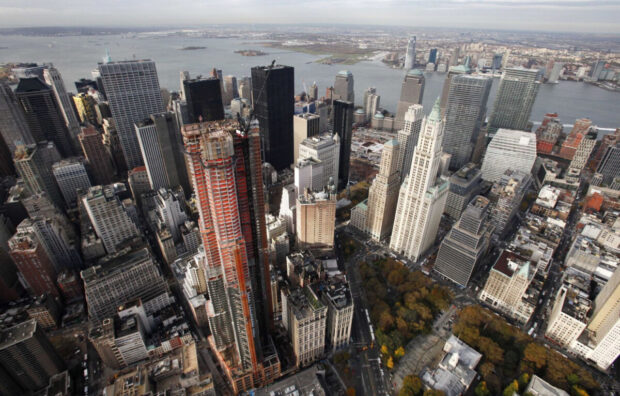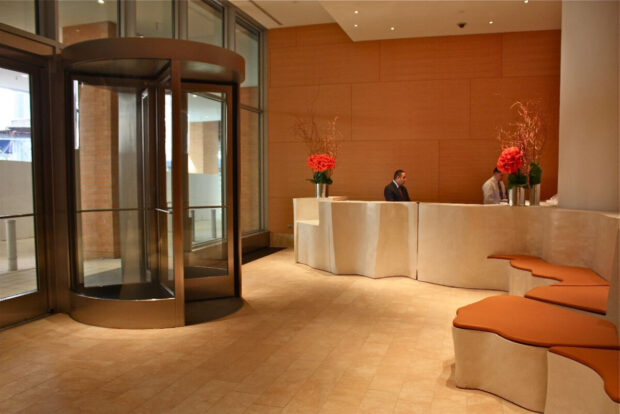The US star architect Frank Gehry has built the tallest residential building in the western hemisphere. The luxury tower is intended to mark the end of the New York architectural doldrums. Not only does it disappoint critics, but it could also turn out to be a financial problem.
“What Frank likes,” says Maryanne Gilmartin, “we like it too.” She stands in a long hallway and points to the neon tubes under the ceiling, which are not aligned in a straight line, but rather form a serpentine line to the window at the end, through which the view of Lower Manhattan falls, 36 floors below.
Art in building construction: It was, of course, Frank’s idea to attach the tubes like this. Because Frank is Frank Gehry – the headline-grabbing star architect who made the city of Bilbao world famous with the Guggenheim Museum and who gave the Disney Group a touch of high culture with its concert hall in Los Angeles.

From the Gehry Tower, you can look at Ground Zero.
But only now, after prestige projects on almost every continent, Gehry conquers Manhattan, the playground of international architecture.
Sure, he’s already designed a commercial building here. Condé Nast publishing house cafeteria in Times Square and the Japanese fashion designer Issey Miyake’s flagship store in Tribeca. But these were industrial jobs, cool commissioned work, invisible in the skyline.
What, on the other hand, now sticks to the sky above the maze of alleys in the Financial District, 265 meters and 76 stories high, is something completely different. It’s not just Gehry’s first skyscraper (the architect is afraid of heights). Not only is it, with 903 nested rental apartments, the tallest and most unusual luxury residential tower in the western hemisphere. According to Nicolai Ouroussoff, architecture critic for the New York Times, it is “the finest skyscraper in New York since Eero Saarinen’s CBS house,” that beacon of modernism from 1965.
New York’s long architectural and construction boom comes to an end here on Spruce Street. It happens in the triangle between City Hall, Brooklyn Bridge, and Wall Street district and also only a few steps away from Ground Zero.
“New York by Gehry” is the immodest name of this apartment giant: New York as Gehry sees it. This, of course, was also commissioned, this time for the billion-dollar real estate company Forest City Ratner. But who worked for whom remains refreshingly unclear.
“We gave him a free hand,” says Gilmartin, Head of Development at Forest City Ratner, as she steers the visitor through the innards, some of which are still under construction – a “vertical city”, as she says, with more than 100,000 square meters of living space Usable area. “The only conditions: it had to be beautiful and promise profitability.”
And so Gehry designed every detail himself, from the glass and stainless steel outer skin to the doorknobs and taps – after all, this is his entry into the Pantheon of Manhattan. At the topping-out ceremony at the end of 2009, he looked up and joked: “No Viagra at all!”

The tower stands between City Hall, Brooklyn Bridge, and the Wall Street district.
Gehry’s style is unmistakable, with the computer-generated curled facade made up of more than 10,500 individual parts, hardly any part is like the other. However, one can argue about the architectural stamina of this “mammoth erection” – and not only because the building does not have an eco-seal, as is usual today.
“Sad and unimpressive,” writes James Gardner in the real estate magazine “The Real Deal”. James Russell from Bloomberg’s business service also remains undecided: “An awkward beauty.” And Schnellbauer Donald Trump is not a fan anyway – which is probably due to the fact that his own penthouse monstrosity at the UN, so far New York’s tallest residential building, is now towered 30 centimeters by Gehry’s Goliath. After all, a meter macho has his pride.
READ: The History of Prohibition in the United States: Its Influence on the Image of the American Mafia
Gehry Tower has become a symbol of the end of the recession in construction and the beginning of a new upswing. The average three-room apartment here costs $ 7,000 a month. For the price, there is also a fitness studio, cinema room, gourmet kitchen, library, terrace with its own hut and barbecue grill, and a glass 15-meter pool: the best life for the winners of the crisis.
The recession has ruined almost everything. Forest City Ratner bought the property from a nearby downtown hospital in 2003 and secured the rights to the high ground in exchange for a park in front of the door and $ 200 million in duty-free loans in exchange for a school in the home. This led to an aesthetic compromise: the tower now stands on a brick block that houses the school and clinic floors and looks like a foreign body.
Construction began in 2006. Then came the crisis. “We moved a short distance,” says Gilmartin. “We were afraid to get rid of 903 apartments.” In 2009, construction was stopped. For six months we thought about closing the 38-story tower, only then we managed to continue construction. “It was complicated.”
In the end, nothing was saved. The lobby is paneled with Douglas spruce, the floor is limestone, and the concierge desk is tiled with hand-chiseled concrete, the puzzle pieces of which were specially shipped overland from California.
At a speed of 426 meters per minute, the elevator rushes upwards so fast that the pressure clogs your ear. “Nobody lives higher,” says Gilmartin as she steps onto the inner construction site on the 76th floor. Eight penthouses are being built here under one roof. The panoramic view spans Manhattan, from the Empire State Building over the Chrysler Building to the end of Central Park, twelve kilometers away. On the other side, the port opens with the Statue of Liberty.
To the west, deep down, Ground Zero. There the drawing board monster of the former Freedom Tower grows out of the pit – a sharp contrast point that will one day more than double Gehry’s vision.
From up here, you can even see the old cousin of the Gehry Tower on the copper roof. The 1913 Woolworth Building, across from City Hall Park and about 25 meters lower, was once the tallest structure in the world. And just as it once marked the beginning of a new era, so Gehry now also wants to show the way into the future.
READ Most Famous Artists from New York and Their Masterpieces
Gilmartin presents the model apartments, furnished in the Faux Bauhaus style that is so popular with Manhattan’s modernists. The one-room cell for singles, the two-room apartment for “the couple transplanted from Los Angeles”, the “family unit” with a children’s room.

The lobby is paneled with Douglas fir, the floor is covered with limestone, the concierge counter is clad in hand-chiseled concrete, the puzzle pieces of which were specially carted from California.
Almost no two apartments are the same; there are more than 200 different floor plans. All somehow the same and somehow conventional – despite stainless steel fittings, despite oak parquet, despite Gehry.
READ The Ringling Bros. and Barnum & Bailey Circus
The fact that Gehry’s Höhenluft apartments are rented out instead of sold also reveals that the real estate market has not yet really recovered. “There are too many condos,” Gilmartin admits. Even the luxury tenants have to be scolded and haggled: if you sign a lease for 13 months, you get one month free.
Like us on Facebook for more stories like this: